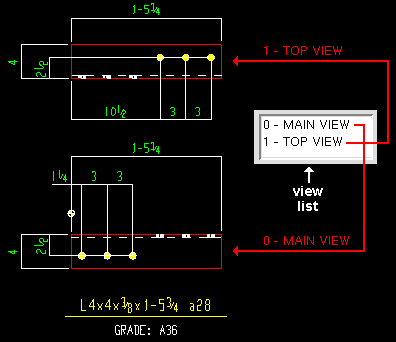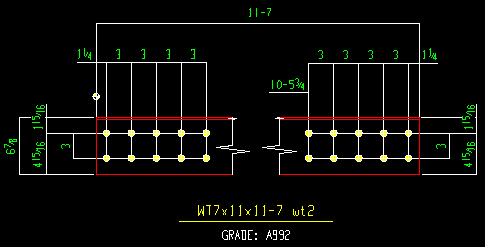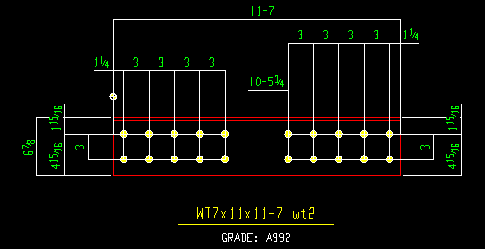Material Isolation ( Modeling , edit views mode)
Also see :
|
- Material isolation's two modes (topic)
- Material isolation's edit the material mode (a related mode of material isolation)
- Material View Defaults (setup of depth checking)
- Detail Submaterial (draws each material view -- except, possible ' SURFACE TEMPLATE ' -- that is on view list)
- Depth check controls (can change a view's depth check limits, permanently if followed by " Save ")
- Find Material (isolates materials in a different way)
- Display Options (isolates materials in a different way)
- Status Display (isolates with ' None ' and ' Masked ')
- Material Drafting (another way to add views in the Drawing Editor )
- Member isolation solid display type (affects material isolation as well as member isolation)
- Save View As (can be used in material isolation)
- Creating an unrolled surface template (topic)
page 1 | contents | material | top
To isolate a material :
page 1 | contents | material | top
How material isolation relates to detailing :
|
In this example, two views are shown on the view list . These views are ' 0 - MAIN VIEW ' and ' 1 - TOP VIEW '. The view named ' 1 - TOP VIEW ' was added in material isolation. After Detail Submaterial , both views were also shown on the submaterial detail. |
page 1 | contents | material | top
View list
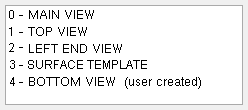
|
Detail Submaterial incorporates views on the view list into the isolated material's detail. The possible exception is a ' SURFACE TEMPLATE ', which may not be detailed, for example, if it is an HSS/TS without cuts -- click here . |
page 1 | contents | material | top
Open

1 . Select any name listed in the view list .
2 . Press the " Open " button to open the selected view.
A special case: You cannot Open a ' SURFACE TEMPLATE '. As described here , a ' SURFACE TEMPLATE ' is only applied to the submaterial detail (during Detail Submaterial ).
Tip: You can double-click a view name to open that view without having to press the " Open " button.
page 1 | contents | material | top
New

Press the " New " button to cut a section view transverse to two points that you locate. Any view that you create in this manner will be regenerated on the submaterial detail created when you Detail Submaterial .
1 . With the view that you want shown on screen:
1a : Press the " New " button.
2 . Locate- Pan -Return mouse bindings are activated along with various Locate options.
|
|
|
bindings |
2a : Select the Locate icon that you want (if it isn't pressed already).
2b : Place the mouse pointer so that the point location target snaps to a point through which you want the view drawn, then left-click ( Locate ).
3 . The status line prompts, "Locate second point."
|
|
|
bindings |
3a : Left-click ( Locate ) when the point location target is at a second point through which you want the view drawn.
Note: The arrowhead that appears as you move the mouse pointer points in the direction you will be looking when you open the view you are creating. Generally you will want the arrow facing toward the material.
4 . The new view you create appears in your current view as a grid line (a blue line with a number labeled on it). The view is numbered in the order in which it was created. In the view list , the new view is the last name listed, and it is named " CROSS SECTION (user created) ." Do either of the following:
Alternative 1 : Repeat steps 2 and 3 to add more new views.
Alternative 2 : Right-click ( Return ) if you are done adding views.
Warning: Material views created using the above method are automatically incorporated into 2D submaterial details that are generated when you Detail Submaterial . If you don't want this to happen, use Delete to remove them before you press " OK " to exit isolation.
page 1 | contents | material | top
Preset

Press " Preset " to get a list of preset views that you can add to the view list . Any view added in this manner will automatically be drawn on the detail of this submaterial when you Detail Submaterial .
1 . Press the " Preset " button.
2 . A window opens. On it is a list of preset views. Tip: To see what any view except a ' SURFACE TEMPLATE ' looks like, check its box, then Open it. You cannot view a surface template in isolation.
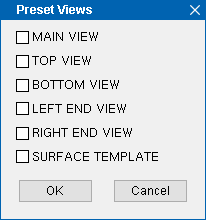
|
A ' SURFACE TEMPLATE ' can generate a view in the submaterial detail during Detail Submaterial if the material is a rectangular plate or pipe or bent plate or HSS/TS or round plate or rolled plate or flat plate layout or bent plate layout or flat bar or cold formed channel or cold formed Z . An HSS/TS or pipe material must also have undergone a Fit operation. A rectangular plate or flat bar or round plate or flat plate layout must have been bent. Click here for an example of a surface template. |
2a : Check the box (
) next to each of the views that you want to include on the submaterial detail, then do one of the following:
Alternative 1 : Press the " OK " button. Go to step 3 or 4.
Alternative 2 : Press " Cancel " to end this operation. Do not continue.
3 . Skip this step if it does not apply. The Duplicate View dialog opens if you attempted to create a preset view of a type that already exists. The dialog informs you of the type of duplicate view that has been detected and gives you three options for saving your new view:
"Insert" adds the new, duplicate preset view to the view list.
"Replace" replaces the view that is currently on the view list with the new, duplicate view.
"Abort" cancels the adding of the duplicate view.
4 . The preset views selected in step 2 are now listed in the view list , after system-created views. The words "(user created)" are written in parentheses after the new views.
Note: All views on the view list are automatically drawn on submaterial detail when you Detail Submaterial .
Also see: Depth checking defaults for preset views are set up in Home > Project Settings > Fabricator > Material View Defaults . You can use depth check controls followed by " Save " to override those depth checking defaults for individual preset views.
page 1 | contents | material | top
Delete

Press " Delete " to open a list of views that you can delete. All views but your current view will be shown on the list.
1 . Begin this operation with a material of any type in isolation.
1a (if applicable) : Open a view that is not one of the views you want to delete.
1b : Press the " Delete " button on the toolbox.
2 . The Select View(s) to Delete window opens. On it is listed every view that is in the view list , with the exception of your current view.
2a : Select the view(s) you want to delete.
2b : Press the " OK " button.
3 . The views you selected are erased, and you remain in the view that you started in. The remaining views in the view list are renumbered in order to preserve the order in which they were added.
Warning: Deleting a view prevents it from being drawn when you Detail Submaterial .
page 1 | contents | material | top
Save

Press the " Save " button to save changes made to your current view under a new name or to save a duplicate view if your current view has not changed. Note: You need to press " Save " in order to retain changes made using " Clip " or " Unclip ."
1 . Before you can Save , you may (optionally) want to first perform an operation on a view that causes the view to change. Tools that relocate a view include Depth Checking , Snap to Surface , Snap to Farside Surface and Snap to Adjacent Surface . You also need to press " Save " in order to retain changes made using " Clip " or " Unclip ."
1a . Press the " Save " button on the toolbox. Go to step 2 if your current view has not changed. Or go to step 3 if your current view has changed.
2 . Skip this step if it does not apply. If your view has not changed since you originally isolated the material, the " Create Submaterial View " window opens.
Alternative 1 : Press the " New View " button to cause a new duplicate of your current view to be listed in the view list . The new view will be called " Detail VIEW ." Do not continue.
Alternative 2 : Press the " Cancel " button to cancel this operation without creating a new view. Do not continue.
3 . The Save Submaterial View window opens. It notifies you that your current "View has changed." Press one of the following buttons:

"Save" saves the changes to your current view. Go to step 4.
"New View" saves your on-screen perspective as a new view.
"Cancel" ends the save operation and keep everything as it was before step 1.
4 . The view you started in remains your current view. If you created a view with a new name using this procedure, that view is the last view on the view list and has (user created) written next to it.
Note: The " Save " button does not produce the same results as choosing File > Save View As... . " Save " gives you a material view. Save View As... gives you an erection view.
page 1 | contents | material | top
Save Area

Press the " Save Area " button to save an area view. Be careful: If the material is not a member main material, this operation may not work. Once this operation is done, you can:
To Save Area :
1 . Begin this operation with a member main material shown in isolation. If the material is not a member main material, this operation may not work.
1a : Press the " Save Area " button on the toolbox.
2 . The status line prompts, "Locate area to save." Locate- Pan -Return mouse bindings become active.
|
|
|
bindings |
2a : Hold down the left mouse button ( Locate ) and drag your mouse pointer to form an area box around the material you want to include in the area view.

3 . The Name Required window opens. On it are the following entry fields:
Detail scale (Base 12 or Base 10) : If the words (Base 12) are in parenthesis, then make your entry in ' I mperial ' units (X inch = one foot, where X is the number of inches on the drawing that you want to represent 1 foot at the construction site). If the words (Base 10) are in parenthesis, make your entry in ' Metric ' units (X mm = 10 mm). The default scale is the " Drawing scale " on the Display Options window for your current erection view (the view that was open when you isolated this material). The value you enter is the scale applied when you first detail this 2D erection view . Subsequent versions of that drawing regenerated from this view use the scale entered to " Drawing scale " in the Drawing Data Panel.
Drawing name: Any character string (up to 61 characters) that you want to use as the name for this view. Unless you want this view to overwrite an existing erection view (see below ), you should give this view an original name that has not been given to other views.
Erection view type: Primary or Secondary or Dimension only or Placement only . Select the erection view type based on how you want the view's grid line dimensioned when you Detail Erection Views and choose to " Annotate erection views ." Note: Locate options in Modeling such as INCL or INCM snap to points on erection views of any of these types.
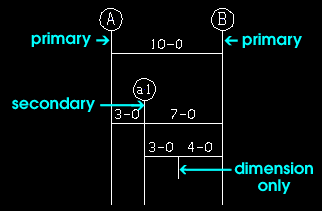
' Primary ' dimensions appear above ' Secondary ' dimensions. ' Dimension only ' erection views are auto dimensioned, but not with grid markers. ' Placement only ' erection views cannot be auto dimensioned (" Annotate erection views "). Pen color: The color of the erection view that Save Area will add. Since the grid line associated with the view added using Save Area will always be a straight grid line , this sets the color of the grid line in Modeling only. Straight grid lines are not generated when you Detail Erection Views . They can be automatically dimensioned on erection view drawings, but they do not themselves appear on the erection view drawings.

Line type: The dash pattern of the erection view that Save Area will add. This sets the line type of the grid line in Modeling only. Grid lines are not generated when you Detail Erection Views .

The button that is pressed sets the line type (dash pattern) of the area view that you are adding.

Alternative 1 : Press " OK " to save the view and go to step 5 (or 6).
Alternative 2 : Press " Cancel " to end the Save Area View operation without creating a new view. Do not continue.
5 . Skip this step if it does not apply. If you typed in the name of a view that already has been created, you get a confirmation dialog with the message, "Do you want replace the existing view?"
Alternative 1 : Press " OK " to replace the view that already has that name with the view you are saving. Go to step 6.
Alternative 2 : Press " Cancel " to end the Save Area operation without creating a new view. Do not continue.
6 . The view you started with in step 1 continues to be displayed on screen. Since you have created an erection view (not a submaterial view) using this tool, the view is not listed in the view list.
page 1 | contents | material | top
Clip

| Applications: Clip can be useful for member main material. You probably don't want to use it on other types of submaterial. |
|
To do a Clip operation:
1 . While looking at a material isolation view that shows the area that you want to clip:
1a : Press the " Clip " button.
2 . Locate- Pan -Return mouse bindings become active.
|
|
|
bindings |
2a : Hold down the left mouse button ( Locate ) and drag the mouse pointer to form an area box around the section of the material you want cut away in the 2D submaterial detail when you Detail Submaterial .
3 . On the Modify View window, do one (1) of the following:

Alternative 1 : Press " Inside " to save the area inside the area box.
Alternative 2 : Press " Outside " to save the areas outside the area box.
Alternative 3 : Press " Cancel " to end the Clip operation without changing anything.
4 . Clip draws a dashed rectangular box around the area that you designated in step 2. Also, one of the following happens:
Possibility 1 : An X is placed inside the region surrounded by the dashed box if you pressed the " Outside " button (in step 3). The X marks the area that will not be drawn on this particular view when you Detail Submaterial and select this material's mark.
Possibility 2 : A simple dashed box (without an X in it) is shown if you pressed the " Inside " button (in step 3). The dashed box marks the area that will be drawn on this particular view when you Detail Submaterial and select this material's mark.
page 1 | contents | material | top
Unclip

|
1 . While looking at a material isolation view that has had a Clip operation performed on it:
1a : Press the " Unclip " button.
2 . Unclip removes the dashed line around the clipped area.
Note: If you did a Detail Submaterial on this material while this view was clipped, you will have to Detail Submaterial again in order to generate a drawing that includes your current, unclipped view.
page 1 | contents | material | top
OK


